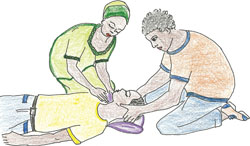7.4.2 Emergency care for someone with a head or spinal injury
When you suspect an individual has a head or spinal injury, the first thing to make sure is whether the person’s airway is clear, so he or she is able to breathe. Then check for signs of blood loss and shock as described earlier. It is very important to keep the person at rest, not moving, and in the position you found him or her. When you approach the injured person, approach from the foot end, to reduce the risk of moving their head or neck and causing further damage.
After giving basic life-supportive care (described in the final section of Study Session 8), the next step is to prepare the injured person for transportation to a health facility. This primarily involves protecting and stabilising the spinal cord in the neck, so that it cannot move and cause more serious damage, which may lead to death or permanent disability. Apply sandbags or pillows on each side and at the back of the neck to immobilise the person’s head and neck (Figure 7.7).

7.4.1 Causes, signs and symptoms of head and spinal injuries
